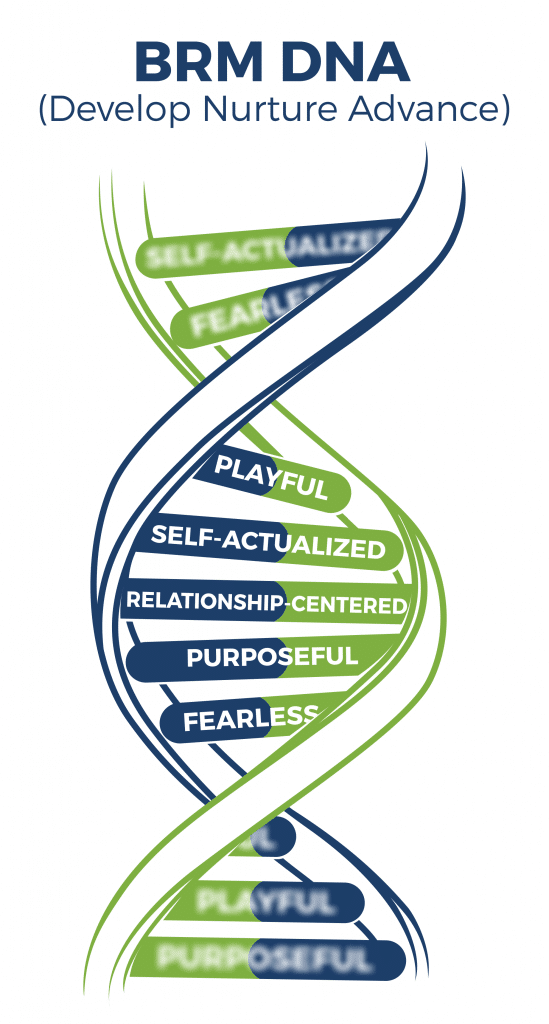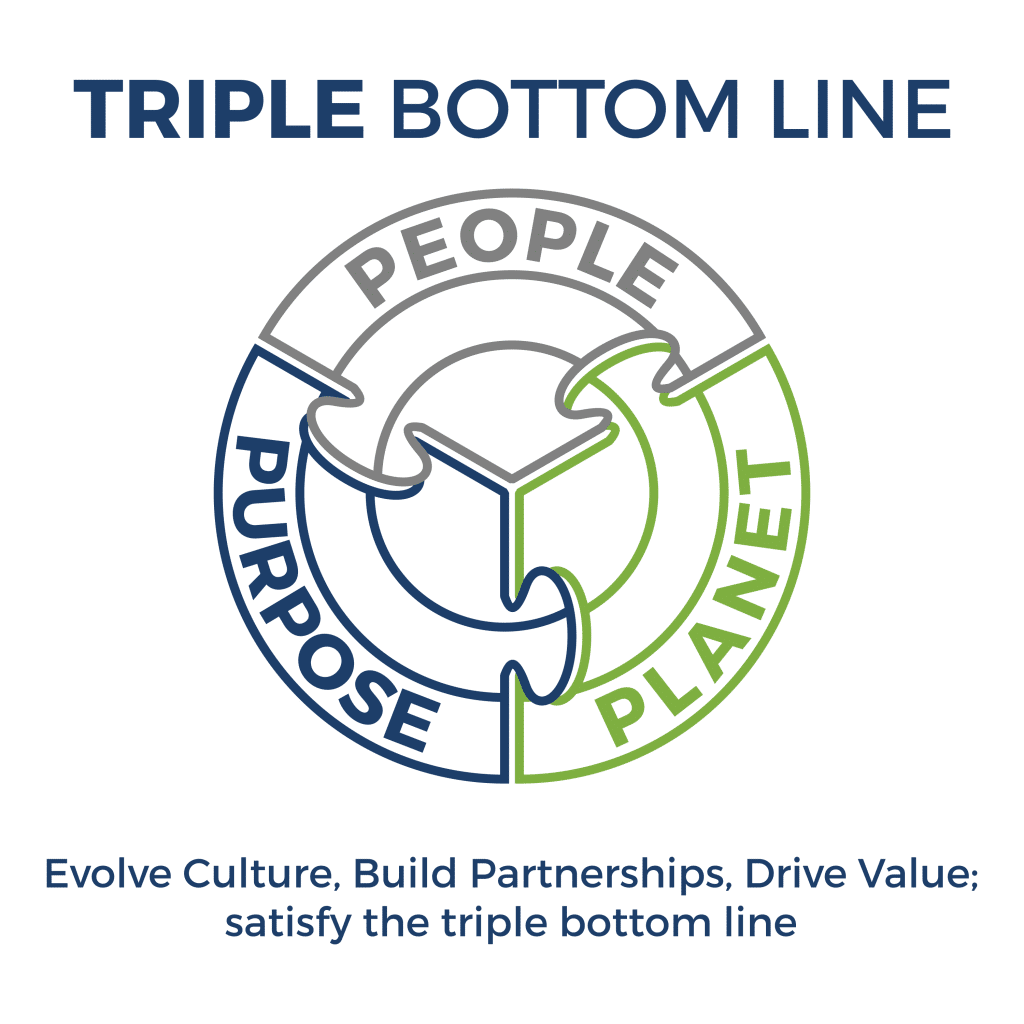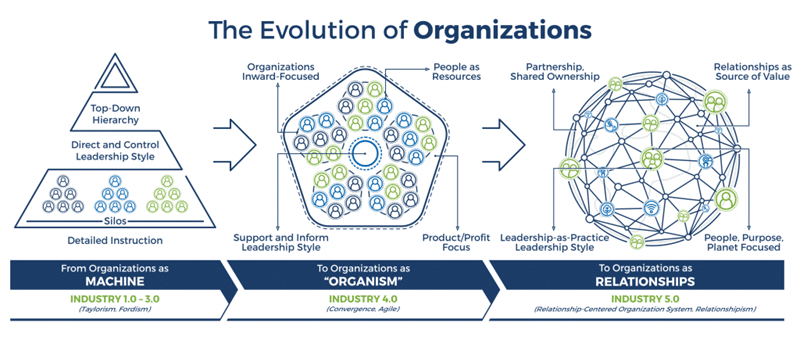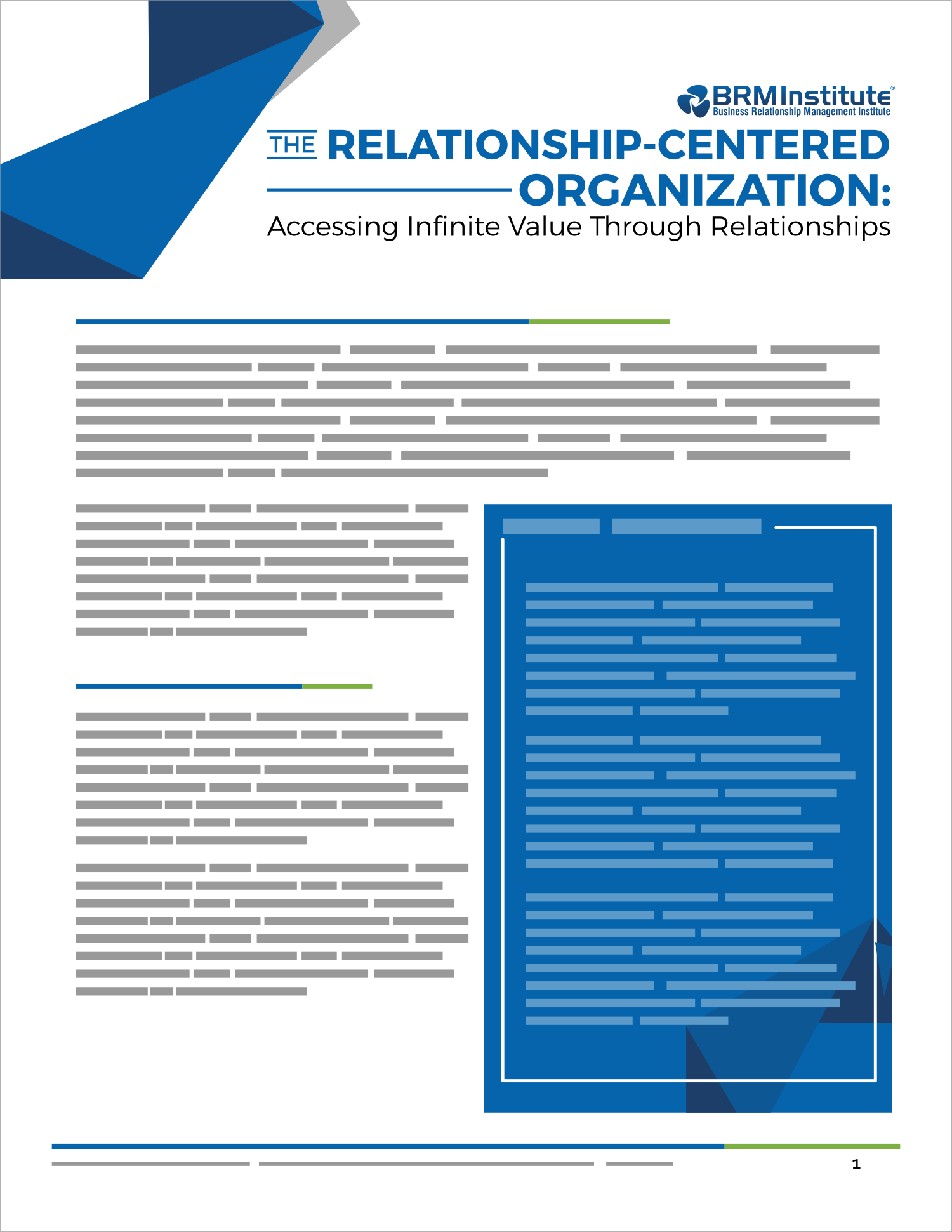The Relationship-Centered Organization: Accessing Infinite Value Through Relationships

The Relationship-Centered Organization
Since people have come together to form organizations, an intangible, abstract entity has been observed. Within companies, schools, hospitals, agencies, or any form of organization, it has been called many things—the core, the heart, the DNA, or even the soul. Like gravity, you can’t see it or touch it. But also like gravity, you can observe and feel it. It is thought to be the hidden logic behind why organizations behave in the distinctively unique ways they do, for the good and the bad. While called many things, one word gets the most press: culture.
Organizational culture is discussed extensively in business literature, and many people have defined it and suggested what you can do to affect it. But until now, there has not been a good theory as to why it exists or how an organization can understand it most effectively to harness an unlimited supply of energy and position your organization to create infinite value. Enter, the Theory of Relationshipism.
What is the Theory of Relationshipism?
While definitions of organizational culture vary, most center on it being a set of shared beliefs and attitudes that shape an organization. Notice how such definitions give human qualities to an abstract entity like culture. But again, explanations only go so far. In search of exponentially higher value, the Theory of Relationshipism examines why organizational cultures exist, where they come from, and how to better understand them. Let’s start from the beginning.
The Genesis of Culture
An organization’s culture doesn’t just materialize, and it isn’t random. It is a reflection of human behavior, which is why it is often defined using human traits. More specifically, culture is an echo of all the interactions and relationships between any people having anything to do with the organization, past or present. To illustrate, consider this short story:
Definition of Relationship
In a general sense, the term relationship can refer to the nature of a connection between two or more concepts, objects, or people. However, in the context of this paper, the term is expressly about the connection between people. And not just any personal human relationship, but those that have an organizational (or business) reason for the relationship. Such an organizational setting implies an expectation of creating value or producing results of some kind; therefore, the need for people in the relationship to communicate and do things together is implicit. Consequently, in the scope of this paper:
Relationship: The state of connectedness between two or more people which dictates the manner in which they interact, communicate, and behave with each other in pursuit of a shared organizational purpose.
Jill started a business with a good product. In a short time, she built solid working relationships with key customers and suppliers, and they gave her feedback on ways to improve. Even as an organization of just one, these relationships shaped a culture based on listening and innovation. As the organization grew, she hired a team—John for Process Implementation and Tom for Sales and Marketing. Jill encouraged Tom to listen to customers and anticipate their needs. Tom did this well, but John was not ready for his disruptive ideas while setting efficient processes. Jill liked John because he had the ability to organize things very well, so she often got what he needed. However, because of the pushback, Tom stopped bringing ideas to John, and customers learned it was a waste of time to bring concerns to Tom. Gradually, because relationships changed, the culture morphed and was no longer based on listening and innovation.
Culture is the Energy Source
But why are work relationships so powerful? And how are they able to change the course of an entire organization? Try this thought exercise:
Take a moment and think about the best work relationship you ever had. Picture that person in your mind. Think about what you accomplished together, the fun you had, and the creative sharing and mutual growth. Let’s call that wonderful relationship your “R.” Now, imagine that same kind of relationship existed between you and everyone in your immediate team. What could you get done? Now, imagine that between everyone who has anything to do with your organization. Would the value potential of your organization be limitless, or even infinite?
When you think of your R, I bet you feel highly motivated. Accomplishment, joy, learning and helping others are motivating. In short, great relationships are motivating to all people involved, and that kind of motivation unlocks a unique creative ability. This is the power of great work relationships. Bottom line: Work relationships serve as the primary energy source that fuels culture.
The Infinite Potential
If more motivating Rs are the energy source that fuels value, how can the tank be kept full with good fuel? The Theory of Relationshipism defines that guidance as Purpose.
But what is the secret behind a good Purpose? Passion! People interested in their organization’s Purpose are passionate. For employees, it isn’t just a job. It is something they believe in. Passionate employees are more engaged and productive. Most importantly, a strong Purpose gives context, stability and consistency for great, enduring work relationships. And, the more relationships that develop into great ones, the energy to create value skyrockets. When you consider how many opportunities every organization has for great relationships between everyone having anything to do with an organization, the potential energy source to create value is limitless. Bottom line: Purpose sets the context for so many effective work relationships that the energy supply to create value has unlimited potential.
The Relationship-Centered Organization System
Now, let’s apply the Theory of Relationshipism to the next evolution of organizations: The Relationship-Centered Organization System. Traditional organization models view work relationships as a necessary requirement to get the job done. As a result, the number of Rs is small and the value potential of such an organization is finite. A Relationship-Centered Organization turns the traditional system on its head. Instead of viewing the product as the core focus, it places purposeful relationships at the center, knowing that the product will come in massive quantity and higher quality as the proportion of Rs goes up. Work relationships require four basic things to lay the foundation to become Rs: Context, Relationship Abilities (DNA), the right Mindset, and the willingness to share useful Knowledge.
The Context of Rs
Remember your R, your best-ever work relationship? Ask yourself, what was the underlying purpose for it. Did that foundation light a fire inside you?
Most effective work relationships are built on something that excites passion. All organizations are perceived by the world and their employees by their Purpose and their performance around a few key factors. To a relationship-centered organization, these factors create a positive perception of purposeful results. They can also be used as a way to set deeper context of work relationships linking organization Purpose to individual Purpose:

Human Factor – The recognition of an individual’s imagination and creative gifts.
Brand Factor – The opportunity to take pride in an organization and its Purpose.
Innovation Factor – The freedom for discovery of new sources of value and creativity.
Technology Factor – The ability to solve problems and issues that really matter.
Infinite Factor – The chance to belong to something that provides lasting, meaningful value.
These factors provide context for great work relationships. Relationships may change over time, but mutual respect of all the factors will lay a solid foundation for work relationships.
The DNA of Rs
Once again, think back on your R. What traits or skills did you bring to the table that helped Develop, Nurture, and Advance (DNA) that relationship? What traits did the other person bring? More than likely, things like cooperation, empathy, and communication come to mind. So, how do relationships Develop, Nurture, and Advance into Rs on an organizational scale?
Consider a team of people building a house. Assume everyone has technical skills that allow them to swing a hammer, read blueprints, or take accurate measurements. These are required functional skills. But hopefully, they also possess another skillset. A skillset that allows them to communicate, express an idea, or understand the needs of their teammates. In the end, these relationship skills are equally important. If nobody communicated or listened, the house would never get built.
A traditional organization tends to focus on functional skills and sees relationship skills as “nice-to-have.” In contrast, a Relationship-Centered Organization gives equal attention to relationship skills and functional skills.

The Mindsets of Rs
When you think about your R, what attitude did you take at first? Was there a teacher-student or leader-follower dynamic? How did it change as time went on? In a true R relationship, individuals invest in each other. They become partners. Partners bring a different mindset to relationships that is unencumbered by rank or perceived importance. Consider the following four archetypes of excellent partnering mindsets:
Connector – Connectors help by expanding their partner’s network of people and ideas.
Cultivator – Cultivators encourage trust, which makes ideas flow freely.
Explorer – Explorers collaborate in an environment of openness and innovation.
Investor – Investors share ownership in the risks and results with their partners.
The Knowledge-Sharing of Rs
Think about your R yet again. What knowledge or experiences did your partner share with you? What did you share with your partner? Did the exchange of knowledge help nurture the relationship?
A strong R relationship depends on the willingness of each party to share their individual knowledge for the betterment of the relationship. Traditional organizations struggle with this need for willingness, wondering why people cling tightly to what they know and often shield it from others. Perhaps such organizations reward acts of individual heroism. They unconsciously give every incentive to individuals to try to stand out from everyone else by what they have between their ears rather than the number of R relationships they are in. In contrast, a Relationship-Centered Organization recognizes R relationships are the ultimate incentive. The rewards of such relationships are immeasurable to the individuals involved in them, so the focus is on developing, nurturing, and advancing such relationships.
What words come to mind when you think about the knowledge either you or your partner provided during your R relationship? Enthusiasm? Conviction? Confidence? Delight? There is good reason why sharing knowledge in a R relationship is so pleasurable: there is much joy in giving and receiving, especially with people you have great relationships with. Think about how great you feel to get an unexpected gift from someone you care about. Or think about how great it feels when someone sincerely acknowledges a gift from you. Your knowledge is a gift to a strong work relationship, and so is that of your partners. When acknowledged with sincerity, the relationship strengthens while creating value and spreading knowledge at the same time.
Purposeful context, relationship-building DNA, and Partnering Mindsets: These things set the foundation for effective relationships that create the energy supply to drive value. A Relationship-Centered Organization invests in them through a critical organizational capability, one that exists in all organizations to one extent or another: A Business Relationship Management Capability.
Business Relationship Management Capability Redefining Value: The Triple Bottom Line
The good news is that within the Relationship-Centered Organization System, Business Relationship Management is a well-defined organizational capability with a clear mission, processes, roles and responsibilities, and metrics that can be summarized succinctly into evolve culture, build partnerships, and drive value. Culture is evolved through the creation and improvement of partnering relationships. Increasing the proportion and quality of great relationships provides an unlimited energy source to drive value. Not just value for the next quarter or next year, but infinite value by expanding the bottom line into the triple bottom line: people, purpose and planet.

People
The value of people who have relationships, now or in the future. They are the source of infinite energy.
Purpose
The value of a great purpose, which generates and sustains passion. It magnifies the source of infinite energy.
Planet
The value of a sustainable future, both a community and environment. It is the ultimate context of infinite value.
The core message of the triple bottom line is that investing in relationships provides a return of infinite proportion back to the organization and its longevity.
The Evolution of Organizations
The Theory of Relationshipism makes way for a new type of organization, one using a Relationship-Centered Organization System.

Organization systems of the industrial ages like Taylorism valued efficiency above all things, resulting in a machine-like culture in which work relationships were expected to be a product of top-down direction and often led to the formation of silos. More recent organization systems try to break down the silos with the formation of more autonomous teams. While more malleable, such organizations still carry forward a finite perspective of value with an inward-focus of creating product and profit. Relationship-Centered Organizations understand the incredible power inherent in the creative human mind and the need for human relationships to supercharge and distribute that power. Relationship-Centered Organizations advance your business relationship management capability and are focused on people, purpose, and planet, not just for benevolent reasons, but because it is in their best interest: It is the only way to position your organization to access infinite value.




[…] In 2020, the BRM Institute introduced the concept of the relationship-centered organization. […]